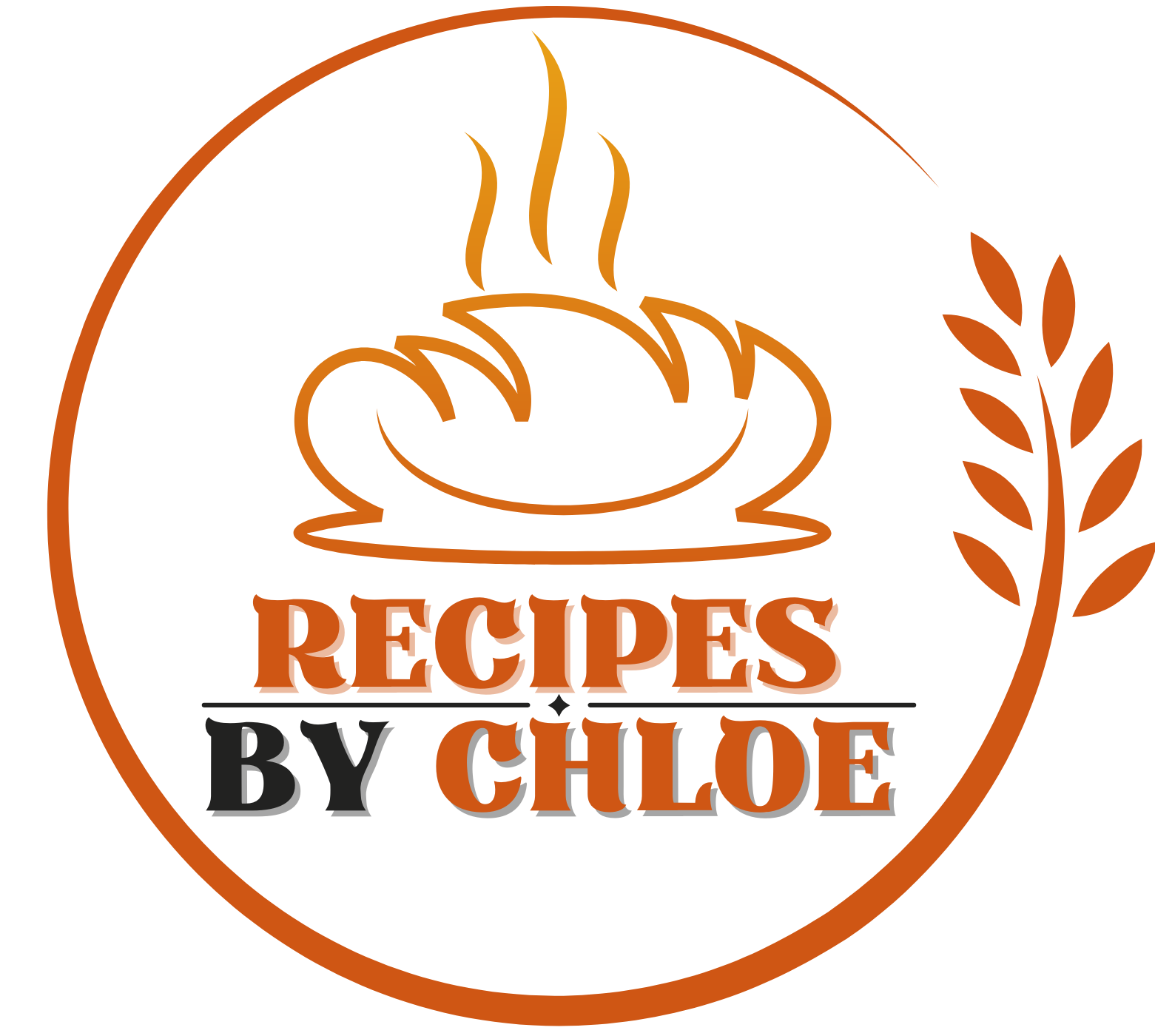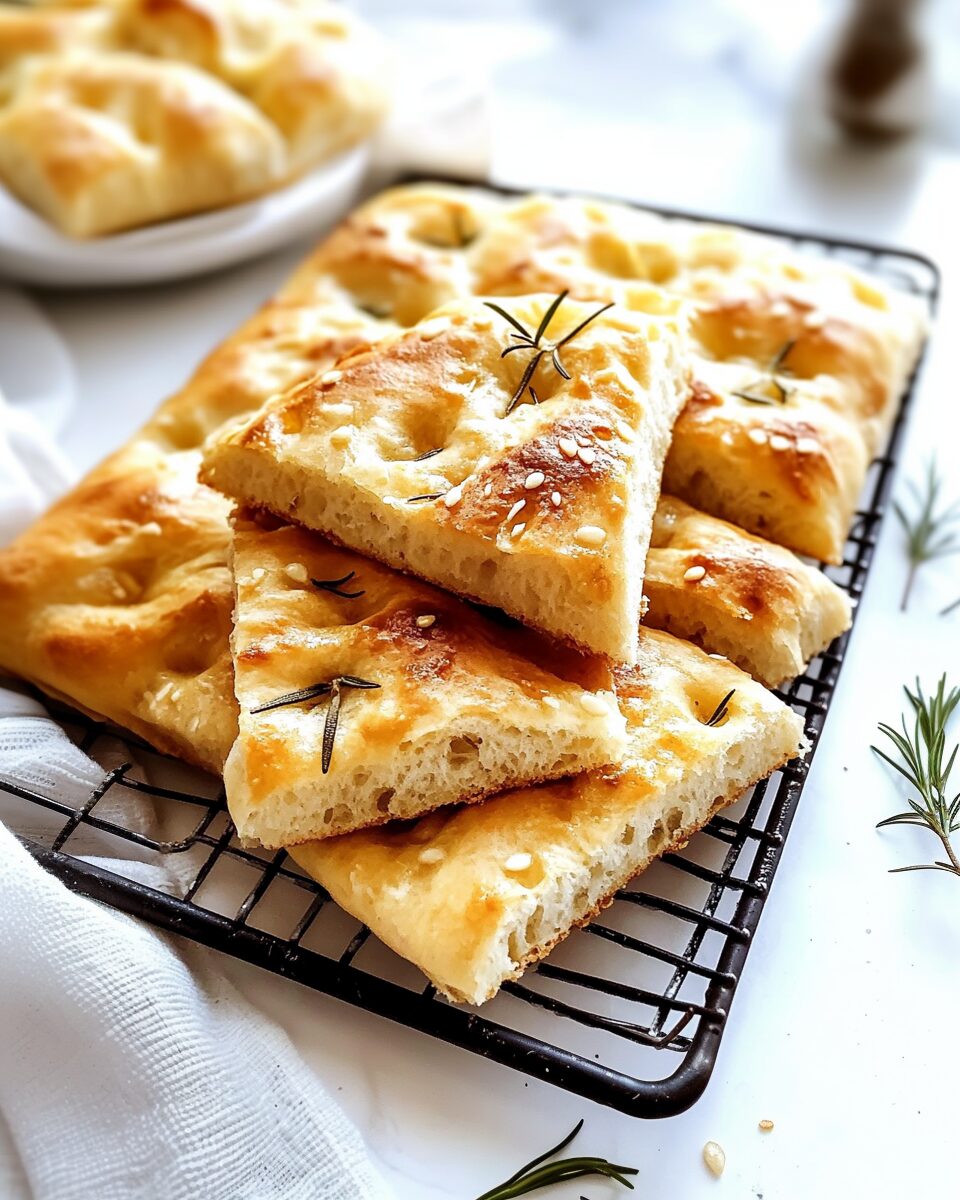This Rosemary Focaccia Bread recipe is a delicious, fluffy, and golden-brown Italian bread infused with fragrant rosemary and sea salt. Perfect as a side dish, sandwich bread, or appetizer, this focaccia is easy to make and only requires a few basic ingredients. The result is a crusty exterior with a soft, chewy center—an irresistible treat for bread lovers!
Full Recipe:
Ingredients
- 1 ⅓ cups warm water (about 110°F)
- 2 teaspoons sugar
- 2 ¼ teaspoons active dry yeast (1 packet)
- 3 ½ cups all-purpose flour
- ¼ cup olive oil (plus more for greasing and drizzling)
- 2 teaspoons fine sea salt
- 1 tablespoon chopped fresh rosemary (plus more for topping)
- Flaky sea salt, for topping
Directions
- In a mixing bowl, combine the warm water and sugar. Stir to dissolve. Add the yeast and let it sit for 5–10 minutes until foamy.
- Add the flour, olive oil, fine sea salt, and rosemary to the bowl. Mix until a dough forms.
- Knead the dough by hand or with a mixer for 5–10 minutes until smooth and elastic.
- Place the dough in a lightly oiled bowl, cover with a damp towel or plastic wrap, and let it rise in a warm place for 45–60 minutes, or until doubled in size.
- Transfer the dough to a greased 9×13-inch baking dish or sheet pan. Press the dough out to fill the pan. Cover and let rise again for 20 minutes.
- Preheat your oven to 400°F (204°C).
- Dimple the dough with your fingers, drizzle generously with olive oil, and sprinkle with rosemary and flaky sea salt.
- Bake for 20–25 minutes or until golden brown.
- Let cool slightly before slicing and serving.
Nutrients (Estimated per serving, based on 12 servings)
- Calories: 210 kcal
- Carbohydrates: 33 g
- Protein: 4 g
- Fat: 7 g
- Saturated Fat: 1 g
- Sodium: 290 mg
- Fiber: 1 g
- Sugar: 1 g
The History and Origins of Focaccia
Focaccia’s roots date back to ancient Rome. It is believed that the Romans made a type of flatbread known as “panis focacius,” which was cooked on hot stones (the word “focaccia” itself is derived from the Latin word “focus,” meaning “hearth” or “fire”). This early form of focaccia was typically flavored with olive oil and salt. Over time, the recipe evolved and spread across different regions of Italy, with variations introduced depending on local ingredients and cultural influences.
Focaccia became a staple in many Italian households, and by the Middle Ages, it was a popular dish in various regions. In Italy, each area developed its own version of focaccia. For example, focaccia in Liguria is often topped with rosemary, while other regions use different herbs, olives, or cheese. The simplicity of the dough—flour, water, yeast, olive oil, and salt—makes it an easy and versatile bread that could be adapted to suit the tastes of the people.
The rosemary focaccia we know today is a product of this long culinary history. The fragrant rosemary not only adds a unique flavor but also enhances the bread’s aroma, making it a memorable experience for anyone who tastes it.
Why Rosemary Focaccia is So Popular
There are many reasons why rosemary focaccia continues to be a favorite among home bakers and chefs alike. First and foremost is the bread’s versatility. Focaccia can be enjoyed in various ways: as a side dish, as a base for sandwiches, or even as a simple snack dipped in olive oil or balsamic vinegar. The rosemary provides an earthy, aromatic quality that complements the bread’s light, airy texture.
Another reason for its popularity is its ease of preparation. While focaccia does require some time for the dough to rise, the process is relatively simple and straightforward. Unlike other types of bread that require complex techniques, focaccia allows home bakers to create a delicious loaf with minimal effort. The dough is forgiving, and even novice bakers can achieve great results.
The texture of rosemary focaccia is another reason it stands out. The outside is golden and slightly crispy, while the inside remains soft and airy. The combination of a crisp crust and a tender crumb makes it an ideal accompaniment to a variety of dishes. The addition of olive oil to both the dough and the top of the bread ensures that it has a rich, luxurious flavor that is hard to resist.
The Key Ingredients in Rosemary Focaccia
While the ingredients for rosemary focaccia are simple, each one plays a vital role in creating the perfect loaf. Olive oil is the star ingredient in this recipe, contributing to the bread’s flavor, moisture, and texture. A generous amount of olive oil is added to the dough itself and drizzled over the top before baking. This not only imparts a rich, savory taste but also helps to create a golden, slightly crispy crust.
How to Serve Rosemary Focaccia
One of the best aspects of rosemary focaccia is its versatility in serving. It can be enjoyed as an appetizer, side dish, or even as a standalone snack. Here are a few ideas for serving your rosemary focaccia:
-
As an Appetizer: Serve warm slices of rosemary focaccia alongside a platter of olives, cheeses, and cured meats for a Mediterranean-inspired appetizer. The bread’s flavor pairs beautifully with tangy cheeses like goat cheese or Parmesan, and its texture is perfect for dipping into olive oil or balsamic vinegar.
-
As a Side Dish: Focaccia makes an excellent accompaniment to a variety of meals. It can be served alongside soups, stews, salads, or pasta dishes. The bread is hearty enough to complement rich, flavorful dishes but light enough to allow the main course to shine.
-
For Sandwiches: Rosemary focaccia can also be used as the base for a delicious sandwich. Its hearty texture holds up well to fillings like roasted vegetables, meats, or spreads. Try it with grilled chicken, fresh mozzarella, and a drizzle of pesto for a simple yet satisfying meal.
-
As a Snack: For a quick and tasty snack, enjoy a slice of rosemary focaccia on its own or with a bit of olive oil for dipping. It’s a great way to satisfy hunger between meals.
Rosemary Focaccia and Health Benefits
While rosemary focaccia is primarily enjoyed for its rich taste, it also has some health benefits, especially when made with high-quality ingredients. Olive oil, a key component in this bread, is known for its numerous health benefits. Rich in monounsaturated fats, olive oil has been linked to a reduced risk of heart disease and can help lower bad cholesterol levels. It is also packed with antioxidants, which help protect the body against free radicals.
Tips for Making Perfect Rosemary Focaccia
To achieve the perfect rosemary focaccia, there are a few tips and tricks that can help ensure success:
-
Use Fresh Rosemary: Fresh rosemary is always preferable to dried rosemary when making focaccia. The fresh leaves have a more vibrant flavor and will release their oils more effectively, creating a more aromatic bread.
-
Allow Enough Rising Time: Be patient with the dough’s rising time. Focaccia dough needs to rise twice: once after mixing and once after being shaped. This helps the dough become light and airy. If you rush this process, the bread will be dense and heavy.
-
Don’t Skimp on Olive Oil: Olive oil is essential to the flavor and texture of focaccia. Be generous with it—both in the dough and when drizzling it on top before baking. The oil helps to create a crispy, golden crust and adds richness to the bread.
-
Experiment with Toppings: While rosemary is the classic topping for focaccia, don’t be afraid to experiment with other flavors. Try adding garlic, olives, sun-dried tomatoes, or even cheese to the top of the dough before baking for a creative twist.
-
Use a Cast-Iron Skillet: For the crispiest crust, consider baking your focaccia in a well-seasoned cast-iron skillet. The heat retention of the skillet helps to create a beautifully golden, crunchy crust.
Conclusion
Rosemary focaccia bread is a timeless recipe that has been passed down through generations, and it continues to be a favorite for its simplicity, flavor, and versatility. The rich aroma of rosemary, combined with the luxurious texture of the olive oil-infused dough, makes it an irresistible treat for bread lovers. Whether served as an appetizer, a side dish, or a base for sandwiches, rosemary focaccia is a bread that brings people together and enhances any meal.






